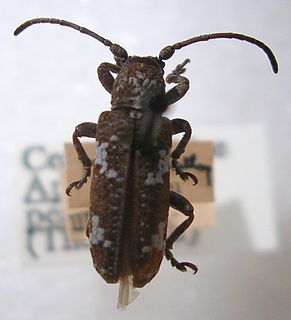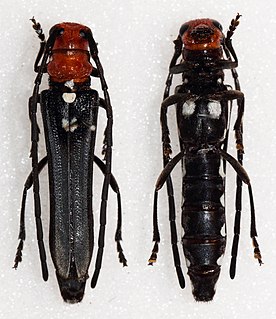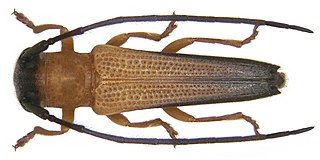Related Research Articles

Maximilian Maria Kolbe, venerated as Saint Maximilian Kolbe, was a Polish Catholic priest and Conventual Franciscan friar who volunteered to die in place of a stranger in the German death camp of Auschwitz, located in German-occupied Poland during World War II. He had been active in promoting the veneration of the Immaculate Virgin Mary, founding and supervising the monastery of Niepokalanów near Warsaw, operating an amateur-radio station (SP3RN), and founding or running several other organizations and publications.

The Togo mouse, also known as Büttner's African forest mouse or the groove-toothed forest mouse, is a unique muroid rodent known from only two specimens taken from near the type locality of Bismarckburg, near Yege, Togo, in 1890. Its genus is monotypic.

Flower chafers are a group of scarab beetles, comprising the subfamily Cetoniinae. Many species are diurnal and visit flowers for pollen and nectar, or to browse on the petals. Some species also feed on fruit. The group is also called fruit and flower chafers, flower beetles and flower scarabs. There are around 4,000 species, many of them still undescribed.
Oskar Alexander Richard Büttner was a German botanist and mineralogist who was involved in the exploration of the Congo Basin.

Heliocopris is a genus of Scarabaeidae or scarab beetles in the superfamily Scarabaeoidea. Forty-seven of the fifty-two known species are found in Africa, but some are found in southern and southeast Asia.

Aloe buettneri is a species of succulent plant in the family Asphodelaceae. It is found in West Africa and is known for its medicinal uses.

Ceroplesis is a genus of flat-faced longhorn beetle in the subfamily Lamiinae of the family Cerambycidae.

Apomecynini is a tribe of longhorn beetles of the subfamily Lamiinae.

Saperdini is a tribe of longhorn beetles of the subfamily Lamiinae.

Lamiini is a tribe of longhorn beetles of the subfamily Lamiinae.

Crossotini is a tribe of longhorn beetles of the subfamily Lamiinae. It was described by Thomson in 1864.
Morimopsini is a tribe of longhorn beetles of the subfamily Lamiinae. It was described by Lacordaire in 1869.
Mycerinus is a genus of longhorn beetles of the subfamily Lamiinae.

Leuconitocris is a genus of longhorn beetles of the subfamily Lamiinae, containing the following species:

Nupserha is a genus of longhorn beetles of the subfamily Lamiinae, containing the following species:
Ceroplesis buettneri is a species of beetle in the family Cerambycidae. It was described by Kolbe in 1863. It is known from Benin, Ghana, the Ivory Coast, and Togo.
Leuconitocris nigricornis is a species of beetle in the family Cerambycidae. It was described by Olivier in 1795, originally under the genus Necydalis. It is known from Tanzania, South Africa, the Central African Republic, Mozambique, Uganda, Malawi, and Zambia.
Leuconitocris tibialis is a species of beetle in the family Cerambycidae. It was described by Kolbe in 1893, originally under the genus Nitocris. It contains the varietas Leuconitocris tibialis var. holoflava.

Nupserha vitticollis is a species of beetle in the family Cerambycidae. It was described by Hermann Julius Kolbe in 1893. It is known from Tanzania, the Democratic Republic of the Congo, Cameroon, Uganda, and Togo.
Phytoecia cylindricollis is a species of beetle in the family Cerambycidae. It was described by Hermann Julius Kolbe in 1893, originally under the genus Blepisanis. It is known from the Ivory Coast, the Democratic Republic of the Congo, Ghana, Guinea, Benin, Gabon, and Togo.
References
- ↑ BioLib.cz - Leuconitocris buettneri. Retrieved on 8 September 2014.